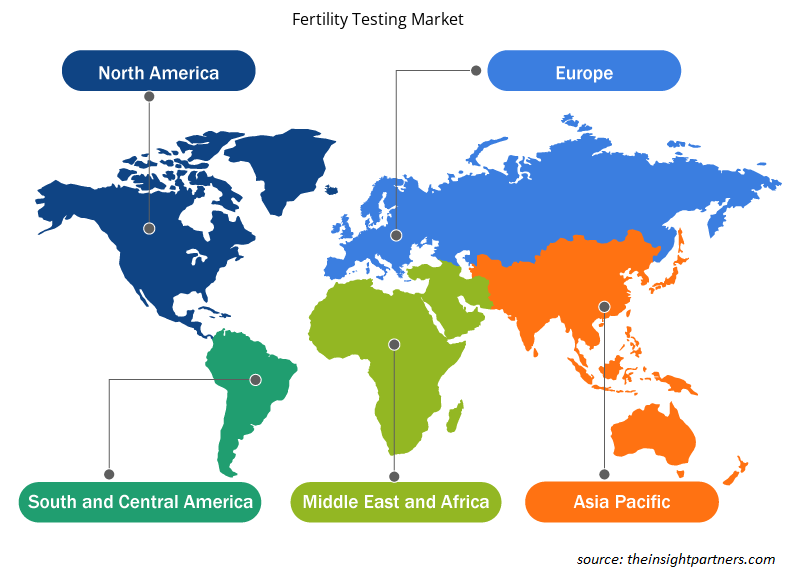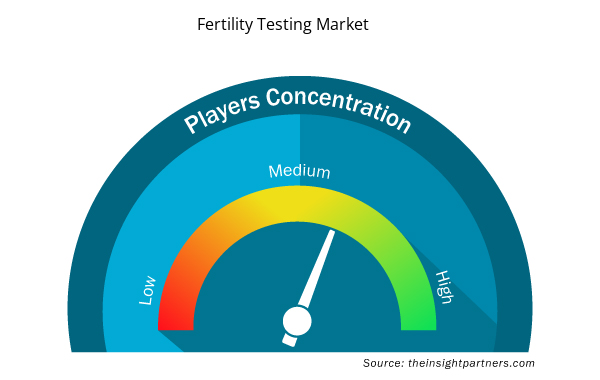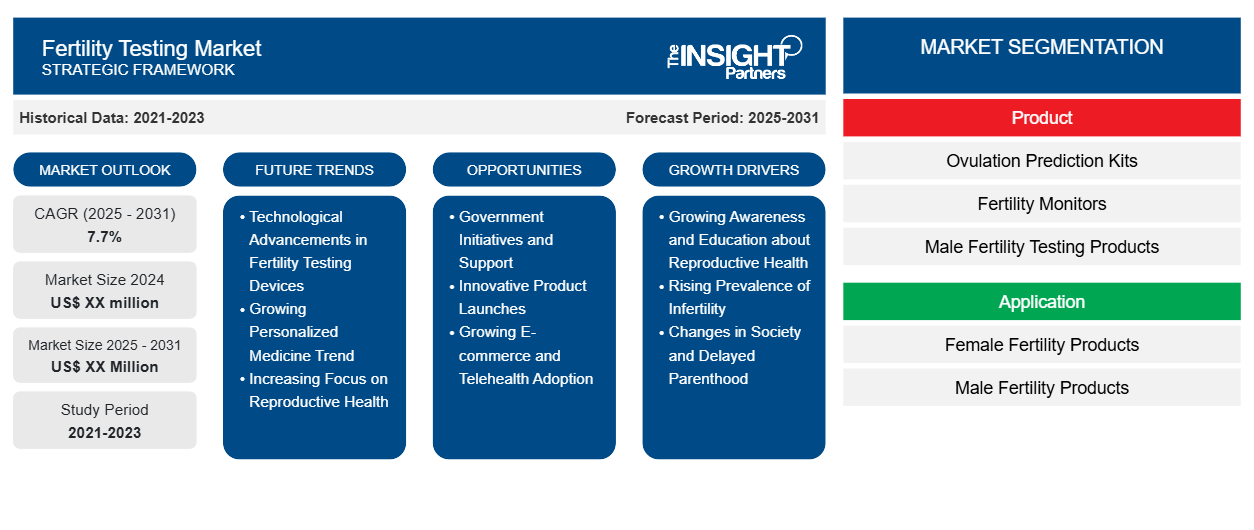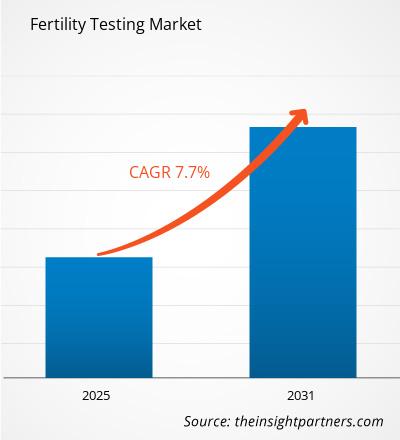Der Markt für Fruchtbarkeitstests wird voraussichtlich von 2024 bis 2031 eine durchschnittliche jährliche Wachstumsrate (CAGR) von 7,7 % verzeichnen, wobei die Marktgröße von XX Millionen US-Dollar im Jahr 2024 auf XX Millionen US-Dollar im Jahr 2031 wachsen wird.
Der Bericht ist segmentiert nach Produkt (Eisprungvorhersage-Kits, Fruchtbarkeitsmonitore, Produkte für Fruchtbarkeitstests bei Männern); Anwendung (Produkte für Fruchtbarkeit bei Frauen, Produkte für Fruchtbarkeit bei Männern); Kaufart (verschreibungspflichtige Produkte, rezeptfreie Produkte, Online-Produkte); Endnutzer (häusliche Pflegeeinrichtungen, Krankenhäuser und Fruchtbarkeitskliniken, Sonstige). Die globale Analyse ist weiter auf regionaler Ebene und in die wichtigsten Länder unterteilt. Der Bericht bietet den Wert in USD für die oben genannte Analyse und die Segmente.
Zweck des Berichts
Der Bericht „Fertility Testing Market“ von The Insight Partners soll die aktuelle Situation und das zukünftige Wachstum sowie die wichtigsten treibenden Faktoren, Herausforderungen und Chancen beschreiben. Dies wird verschiedenen Geschäftspartnern Einblicke geben, wie zum Beispiel:
- Technologieanbieter/-hersteller: Um die sich entwickelnde Marktdynamik zu verstehen und die potenziellen Wachstumschancen zu kennen, damit sie fundierte strategische Entscheidungen treffen können.
- Investoren: Durchführung einer umfassenden Trendanalyse hinsichtlich der Marktwachstumsrate, der finanziellen Marktprognosen und der Chancen entlang der Wertschöpfungskette.
- Regulierungsbehörden: Zur Regulierung von Richtlinien und Überwachungsaktivitäten auf dem Markt mit dem Ziel, Missbrauch zu minimieren, das Vertrauen der Anleger zu bewahren und die Integrität und Stabilität des Marktes aufrechtzuerhalten.
Fruchtbarkeitstests Marktsegmentierung
Produkt
- Kits zur Eisprungvorhersage
- Fruchtbarkeitsmonitore
- Produkte zur Fruchtbarkeitsprüfung für Männer
Anwendung
- Produkte für die weibliche Fruchtbarkeit
- Produkte für die männliche Fruchtbarkeit
Kaufart
- Verschreibungspflichtige Produkte
- OTC-basierte Produkte
- Online-Produkte
Endbenutzer
- Einstellungen für die häusliche Pflege
- Krankenhäuser und Fruchtbarkeitskliniken
- Sonstiges
Passen Sie diesen Bericht Ihren Anforderungen an
Sie erhalten kostenlos individuelle Anpassungen an jedem Bericht, einschließlich Teilen dieses Berichts oder einer Analyse auf Länderebene, eines Excel-Datenpakets sowie tolle Angebote und Rabatte für Start-ups und Universitäten.
- Holen Sie sich die wichtigsten Markttrends aus diesem Bericht.Dieses KOSTENLOSE Beispiel umfasst eine Datenanalyse von Markttrends bis hin zu Schätzungen und Prognosen.
Wachstumstreiber auf dem Markt für Fruchtbarkeitstests
- Wachsendes Bewusstsein und Aufklärung über reproduktive Gesundheit: Das Bewusstsein für Gesundheitsprobleme von Frauen, einschließlich reproduktiver Gesundheit, Wechseljahren und chronischer Erkrankungen, wächst in der Bevölkerung. Dieses gesteigerte Bewusstsein führt zu einer Nachfrage nach speziellen Gesundheitsgeräten, um eine wirksame Behandlung und Behandlung von Frauenkrankheiten zu gewährleisten.
- Steigende Prävalenz von Unfruchtbarkeit: Die Unfruchtbarkeitsrate steigt weltweit bei Männern und Frauen. Da weltweit jeder Sechste von Unfruchtbarkeit berichtet, steigt die Nachfrage nach Fruchtbarkeitstests. Darüber hinaus tragen die zunehmende Inzidenz und Prävalenz von Erkrankungen wie Brustkrebs, polyzystischem Ovarialsyndrom (PCOS) und Endometriose zur Notwendigkeit frühzeitiger Tests bei.
- Veränderungen in der Gesellschaft und verspätete Elternschaft: Die Veränderungen in den gesellschaftlichen Normen und die Tatsache, dass sich viele Menschen aus unterschiedlichen Gründen entscheiden, die Elternschaft aufzuschieben, tragen ebenfalls dazu bei, dass das Risiko für Fruchtbarkeitsprobleme steigt. Eine verspätete Elternschaft führt zu einer erhöhten Nachfrage nach Fruchtbarkeitstests, da die Menschen ihre reproduktive Gesundheit im Verhältnis zu ihren Lebensentscheidungen verstehen möchten.
Zukünftige Trends auf dem Fruchtbarkeitstestmarkt
- Technologische Fortschritte bei Fruchtbarkeitstestgeräten: Innovationen in der Medizintechnik, wie Einweg-Fruchtbarkeitstestkits, Geräte zur Fernverfolgung der Fruchtbarkeit und Telemedizinlösungen, erleichtern es Frauen, ihre Gesundheit effektiv zu verwalten. Diese Fortschritte verbessern auch die Patientenergebnisse und erhöhen die Benutzereinbindung. Fortschritte in der Fruchtbarkeitstesttechnologie haben zur Entwicklung von Geräten geführt, die verschiedene Gesundheitswerte überwachen, wie etwa Eisprungzyklen von Frauen und Heimscreeningtests für Männer.
- Wachsender Trend zur personalisierten Medizin: Der Aufstieg der personalisierten Medizin, bei der Testkits auf der Grundlage individueller Merkmale entwickelt werden, beeinflusst die Entwicklung von Geräten, die eine individuelle Gesundheitsüberwachung und Screening-Optionen für zu Hause für Frauen und Männer bieten. Darüber hinaus können speziell für Frauen entwickelte Anwendungen Symptome verfolgen, Medikamente verwalten und maßgeschneiderte Gesundheitsratschläge geben, was die Nachfrage nach Geräten zur Fruchtbarkeitsprüfung erhöht.
- Zunehmender Fokus auf reproduktive Gesundheit: Das zunehmende Bewusstsein für reproduktive Gesundheit hat zu einer Zunahme von Geräten geführt, die bei der Fruchtbarkeitsverfolgung, der Vorhersage des Eisprungs und dem allgemeinen Management der reproduktiven Gesundheit helfen. Darüber hinaus wird erwartet, dass Innovationen zur Überwachung der Gesundheit während der Schwangerschaft, wie z. B. Fetalmonitore und vernetzte Geräte, in den kommenden Jahren an Bedeutung gewinnen werden.
Marktchancen für Fruchtbarkeitstests
- Regierungsinitiativen und -unterstützung: Viele Regierungen führen Initiativen zur Verbesserung der Gesundheit von Frauen durch, darunter Forschungsgelder und Anreize für Unternehmen, innovative Gesundheitsgeräte für Frauen zu entwickeln. Darüber hinaus hat die zunehmende Anerkennung der Gesundheitsprobleme von Frauen zu erhöhten Investitionen sowohl des privaten als auch des öffentlichen Sektors in die Entwicklung innovativer Gesundheitsgeräte und -lösungen geführt.
- Innovative Produkteinführungen: Die kontinuierliche Einführung neuer Produkte, darunter tragbare Gesundheitsmonitore, Fruchtbarkeitstracker und Heimtestgeräte, fördert das Marktwachstum und geht auf vielfältige Bedürfnisse ein. Darüber hinaus arbeiten Hersteller zunehmend mit Gesundheitsdienstleistern und Technologieunternehmen zusammen, um ihr Produktangebot zu erweitern und breitere Märkte zu erreichen.
- Zunehmende Nutzung von E-Commerce und Telemedizin: Der Aufstieg von E-Commerce und Telemedizindiensten hat Frauen den Zugang zu Gesundheitsgeräten und -beratungen erleichtert und damit die Marktreichweite erweitert. Darüber hinaus spielt die Rolle der sozialen Medien bei der Aufklärung und Stärkung von Frauen in Gesundheitsfragen eine entscheidende Rolle bei der Steigerung der Nachfrage nach Gesundheitsgeräten für Frauen.
Regionale Einblicke in den Fruchtbarkeitstestmarkt
Die regionalen Trends und Faktoren, die den Markt für Fruchtbarkeitstests im Prognosezeitraum beeinflussen, wurden von den Analysten von Insight Partners ausführlich erläutert. In diesem Abschnitt werden auch die Marktsegmente und die Geografie für Fruchtbarkeitstests in Nordamerika, Europa, im asiatisch-pazifischen Raum, im Nahen Osten und Afrika sowie in Süd- und Mittelamerika erörtert.

- Erhalten Sie regionale Daten zum Markt für Fruchtbarkeitstests
Umfang des Marktberichts zu Fruchtbarkeitstests
| Berichtsattribut | Details |
|---|---|
| Marktgröße im Jahr 2024 | XX Millionen US-Dollar |
| Marktgröße bis 2031 | XX Millionen US-Dollar |
| Globale CAGR (2025 - 2031) | 7,7 % |
| Historische Daten | 2021-2023 |
| Prognosezeitraum | 2025–2031 |
| Abgedeckte Segmente | Nach Produkt
|
| Abgedeckte Regionen und Länder | Nordamerika
|
| Marktführer und wichtige Unternehmensprofile |
|
Dichte der Marktteilnehmer für Fruchtbarkeitstests: Die Auswirkungen auf die Geschäftsdynamik verstehen
Der Markt für Fruchtbarkeitstests wächst rasant, angetrieben durch die steigende Nachfrage der Endnutzer aufgrund von Faktoren wie sich entwickelnden Verbraucherpräferenzen, technologischen Fortschritten und einem größeren Bewusstsein für die Vorteile des Produkts. Mit steigender Nachfrage erweitern Unternehmen ihr Angebot, entwickeln Innovationen, um die Bedürfnisse der Verbraucher zu erfüllen, und nutzen neue Trends, was das Marktwachstum weiter ankurbelt.
Die Marktteilnehmerdichte bezieht sich auf die Verteilung von Firmen oder Unternehmen, die in einem bestimmten Markt oder einer bestimmten Branche tätig sind. Sie gibt an, wie viele Wettbewerber (Marktteilnehmer) in einem bestimmten Marktraum im Verhältnis zu seiner Größe oder seinem gesamten Marktwert präsent sind.
Die wichtigsten auf dem Markt für Fruchtbarkeitstests tätigen Unternehmen sind:
- TaiDoc Technologie GmbH
- Fairhaven Gesundheit
- Prestige Brands, Inc.
- BioZhena Corporation
- Babystart Ltd.
Haftungsausschluss : Die oben aufgeführten Unternehmen sind nicht in einer bestimmten Reihenfolge aufgeführt.

- Überblick über die wichtigsten Akteure auf dem Markt für Fruchtbarkeitstests
Wichtige Verkaufsargumente
- Umfassende Abdeckung: Der Bericht deckt die Analyse von Produkten, Dienstleistungen, Typen und Endbenutzern des Fruchtbarkeitstest-Marktes umfassend ab und bietet einen ganzheitlichen Überblick.
- Expertenanalyse: Der Bericht basiert auf dem umfassenden Verständnis von Branchenexperten und Analysten.
- Aktuelle Informationen: Der Bericht stellt durch die Abdeckung aktueller Informationen und Datentrends Geschäftsrelevanz sicher.
- Anpassungsoptionen: Dieser Bericht kann angepasst werden, um spezifische Kundenanforderungen zu erfüllen und die Geschäftsstrategien optimal anzupassen.
Der Forschungsbericht zum Markt für Fruchtbarkeitstests kann daher dabei helfen, die Branchensituation und Wachstumsaussichten zu entschlüsseln und zu verstehen. Obwohl es einige berechtigte Bedenken geben kann, überwiegen die allgemeinen Vorteile dieses Berichts tendenziell die Nachteile.
- Historische Analyse (2 Jahre), Basisjahr, Prognose (7 Jahre) mit CAGR
- PEST- und SWOT-Analyse
- Marktgröße Wert/Volumen – Global, Regional, Land
- Branche und Wettbewerbsumfeld
- Excel-Datensatz



Report Coverage
Revenue forecast, Company Analysis, Industry landscape, Growth factors, and Trends

Segment Covered
This text is related
to segments covered.

Regional Scope
North America, Europe, Asia Pacific, Middle East & Africa, South & Central America

Country Scope
This text is related
to country scope.
Häufig gestellte Fragen
The fertility monitors segment accounts for highest revenue in product sgement in 2023.
TaiDoc Technology Corporation,
Fairhaven Health,
Prestige Brands, Inc. ,
bioZhena Corporation,
Babystart Ltd.,
Church & Dwight Co., Inc. ,
SPD Swiss Precision, Diagnostics GmbH,
UEBE Medical GmbH,
Hilin Life Products, are some fo the major market players operating in the market
The Fertility Testing Market is estimated to witness a CAGR of 7.7% from 2023 to 2031
Asia Pacific region dominated the fertility testing market in 2023
North America region dominated the fertility testing market in 2023
The major factors driving the digital ear thermometer market are:
1.Incresaing awareness of women Health Issues
2. Risisng infertility rates
3. Changes in Society and Delayed Parenthood
Trends and growth analysis reports related to Life Sciences : READ MORE..
1. TaiDoc Technology Corporation
2. Fairhaven Health
3. Prestige Brands, Inc.
4. bioZhena Corporation
5. Babystart Ltd.
6. Church & Dwight Co., Inc.
7. SPD Swiss Precision Diagnostics GmbH
8. UEBE Medical GmbH
9. Hilin Life Products
10. Quidel Corporation
11. Swiss Precision Diagnostics
12. bioZhena
13. Fertility Focus
14. Geratherm Medical
15. AdvaCare Pharma
16. AVA
17. Valley Electronics
18. Sensiia
19. Mira Care
The Insight Partners performs research in 4 major stages: Data Collection & Secondary Research, Primary Research, Data Analysis and Data Triangulation & Final Review.
- Data Collection and Secondary Research:
As a market research and consulting firm operating from a decade, we have published and advised several client across the globe. First step for any study will start with an assessment of currently available data and insights from existing reports. Further, historical and current market information is collected from Investor Presentations, Annual Reports, SEC Filings, etc., and other information related to company’s performance and market positioning are gathered from Paid Databases (Factiva, Hoovers, and Reuters) and various other publications available in public domain.
Several associations trade associates, technical forums, institutes, societies and organization are accessed to gain technical as well as market related insights through their publications such as research papers, blogs and press releases related to the studies are referred to get cues about the market. Further, white papers, journals, magazines, and other news articles published in last 3 years are scrutinized and analyzed to understand the current market trends.
- Primary Research:
The primarily interview analysis comprise of data obtained from industry participants interview and answers to survey questions gathered by in-house primary team.
For primary research, interviews are conducted with industry experts/CEOs/Marketing Managers/VPs/Subject Matter Experts from both demand and supply side to get a 360-degree view of the market. The primary team conducts several interviews based on the complexity of the markets to understand the various market trends and dynamics which makes research more credible and precise.
A typical research interview fulfils the following functions:
- Provides first-hand information on the market size, market trends, growth trends, competitive landscape, and outlook
- Validates and strengthens in-house secondary research findings
- Develops the analysis team’s expertise and market understanding
Primary research involves email interactions and telephone interviews for each market, category, segment, and sub-segment across geographies. The participants who typically take part in such a process include, but are not limited to:
- Industry participants: VPs, business development managers, market intelligence managers and national sales managers
- Outside experts: Valuation experts, research analysts and key opinion leaders specializing in the electronics and semiconductor industry.
Below is the breakup of our primary respondents by company, designation, and region:

Once we receive the confirmation from primary research sources or primary respondents, we finalize the base year market estimation and forecast the data as per the macroeconomic and microeconomic factors assessed during data collection.
- Data Analysis:
Once data is validated through both secondary as well as primary respondents, we finalize the market estimations by hypothesis formulation and factor analysis at regional and country level.
- Macro-Economic Factor Analysis:
We analyse macroeconomic indicators such the gross domestic product (GDP), increase in the demand for goods and services across industries, technological advancement, regional economic growth, governmental policies, the influence of COVID-19, PEST analysis, and other aspects. This analysis aids in setting benchmarks for various nations/regions and approximating market splits. Additionally, the general trend of the aforementioned components aid in determining the market's development possibilities.
- Country Level Data:
Various factors that are especially aligned to the country are taken into account to determine the market size for a certain area and country, including the presence of vendors, such as headquarters and offices, the country's GDP, demand patterns, and industry growth. To comprehend the market dynamics for the nation, a number of growth variables, inhibitors, application areas, and current market trends are researched. The aforementioned elements aid in determining the country's overall market's growth potential.
- Company Profile:
The “Table of Contents” is formulated by listing and analyzing more than 25 - 30 companies operating in the market ecosystem across geographies. However, we profile only 10 companies as a standard practice in our syndicate reports. These 10 companies comprise leading, emerging, and regional players. Nonetheless, our analysis is not restricted to the 10 listed companies, we also analyze other companies present in the market to develop a holistic view and understand the prevailing trends. The “Company Profiles” section in the report covers key facts, business description, products & services, financial information, SWOT analysis, and key developments. The financial information presented is extracted from the annual reports and official documents of the publicly listed companies. Upon collecting the information for the sections of respective companies, we verify them via various primary sources and then compile the data in respective company profiles. The company level information helps us in deriving the base number as well as in forecasting the market size.
- Developing Base Number:
Aggregation of sales statistics (2020-2022) and macro-economic factor, and other secondary and primary research insights are utilized to arrive at base number and related market shares for 2022. The data gaps are identified in this step and relevant market data is analyzed, collected from paid primary interviews or databases. On finalizing the base year market size, forecasts are developed on the basis of macro-economic, industry and market growth factors and company level analysis.
- Data Triangulation and Final Review:
The market findings and base year market size calculations are validated from supply as well as demand side. Demand side validations are based on macro-economic factor analysis and benchmarks for respective regions and countries. In case of supply side validations, revenues of major companies are estimated (in case not available) based on industry benchmark, approximate number of employees, product portfolio, and primary interviews revenues are gathered. Further revenue from target product/service segment is assessed to avoid overshooting of market statistics. In case of heavy deviations between supply and demand side values, all thes steps are repeated to achieve synchronization.
We follow an iterative model, wherein we share our research findings with Subject Matter Experts (SME’s) and Key Opinion Leaders (KOLs) until consensus view of the market is not formulated – this model negates any drastic deviation in the opinions of experts. Only validated and universally acceptable research findings are quoted in our reports.
We have important check points that we use to validate our research findings – which we call – data triangulation, where we validate the information, we generate from secondary sources with primary interviews and then we re-validate with our internal data bases and Subject matter experts. This comprehensive model enables us to deliver high quality, reliable data in shortest possible time.


 Holen Sie sich ein kostenloses Muster für diesen Bericht
Holen Sie sich ein kostenloses Muster für diesen Bericht